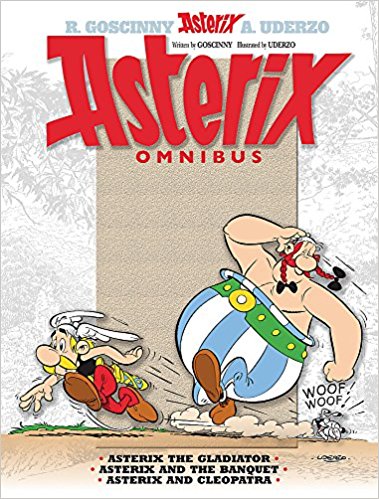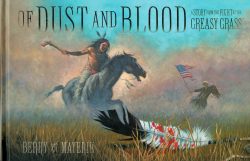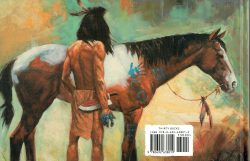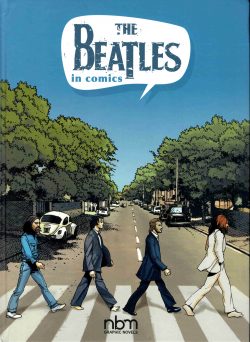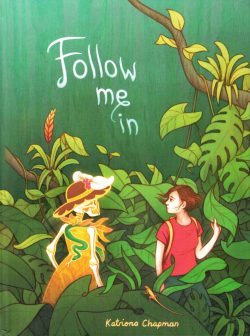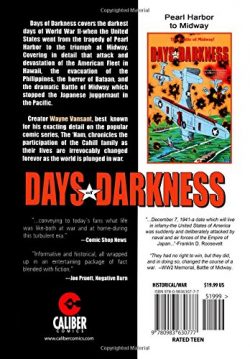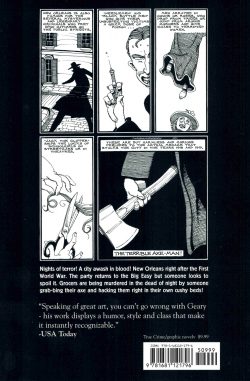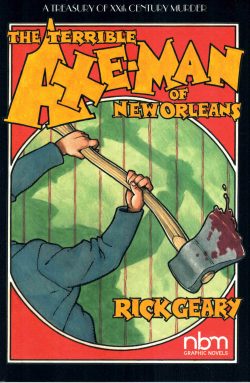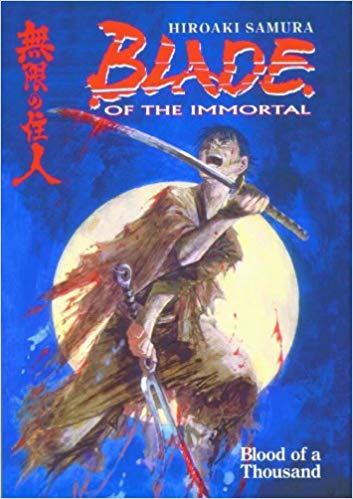
By Hiroaki Samura translated by Dana Lewis & Toren Smith (Dark Horse)
ISBN: 978-1-56971-239-9
Born in Chiba Prefecture in 1970, manga master Hiroaki Samura differs from many of his contemporary colleagues in that he actually pursued classical art training before abandoning oil paints and easels for the monochrome freedom and easy license of the “whimsical drawings†industry.
He was, however, plucked from college in the early 1990s before finishing his degree, to find huge success creating the astonishing fantasy saga Mugen no JÅ«nin (The Inhabitant of Infinity) for Seinen magazine Afternoon.
The series ran from June 25th 1993 to December 25th 2012, a total of 30 volumes which spectacularly blended ubiquitous Samurai comics themes and scenarios with vengeful supernatural plots, political intrigues, existential philosophy and punk-era nihilism. Its driven, murderously efficient antihero constantly deployed his outrageously eccentric arsenal of fanciful edged weapons, whilst pondering the merits of salvation and the meaning and point of living too long…
The series was picked by Dark Horse in 1996 and released as Blade of the Immortal, first as a monthly comicbook series (the first six issues of which comprise this monochrome masterpiece) and, from 2007 onwards, exclusively in collected graphic novel editions. These days you can take the creative anachronism one step beyond and enjoy the high-energy antics in digital fashion…
One note of caution for purists: the series’ dialogue is written in an updated, quirkily moderne literary style which strives for emotional veracity rather than (faux) period authenticity, so it might all be a little disconcerting at first…
Set in middle of the Tokugawa Shogunate (between 1600 and 1868 CE), this first sublimely engaging volume opens with ‘About the Translation’ – a prose section explaining the translation process and the symbology of the piece – before the graphic miracles begin with ‘Prologue: Criminal’; introducing debased and unsavoury ronin Manji: one-eyed outlaw and weary killer looking for peace and redemption in all the wrong places…
The “Slayer of 100 Good Men†– including his own peacekeeper brother-in-law – Manji is currently stalking Gyobutsu “Johnnyâ€: a mass-murderer who kills his victims whilst disguised as a priest.
When a cunning trap goes wrong, the debased ronin manfully ignores a pistol shot through his brain to finish his sacrilegious quarry.
This ronin is no longer as other men. There are worms in his head, and as they knit his inexplicably non-fatal wound back together, Manji broods.
In his despicable past he was a cheap sell-sword who killed as he pleased. When his misdeeds brought him into conflict with his “cop†brother-in-law he simply butchered him. The shock drove his sister Machi mad.
She was the only thing Manji ever cared about…
Yaobikuni has no problem with living forever – she won’t die until she’s saved every soul in Japan – and when the unkillable reprobate again meets the 800-year old nun who inflicted on him the sacred Kessen-chu bloodworms which can heal any hurt, she draws him into the old pointless discussion about salvation.
Yaobikuni urges him to give up the sword, but all he wants to do is die….
Even if he could, it’s no longer an option now that he has to care for his grievously damaged sister Machi…
The problem is savagely solved when the vengeful brother and 20-strong gang of “Johnny†abduct her, determined to make her murderous brother pay emotionally and physically for the death of their leader.
Manji’s botched rescue attempt leaves him triumphant above a sea of corpses and utterly alone in the world…
Pushed too far, he finds Yaobikuni and offers her a deal: if he kills one thousand truly evil men, she must remove the Kessen-chu and let Manji rest at last.
Despite misgivings that he’s just found another way to keep on killing, the nun agrees…
‘Conquest’ debuts young Rin, whose father Asano was targeted for slaughter by a merciless gang of anarchist thugs calling themselves the IttÅ-ryÅ«.
Long ago, the grandfather of their leader Anotsu Kagehisa had been shamefully and unjustly expelled from Asano’s Mutenichi-ryÅ« fencing dojo, and the grandson resolved to destroy all such schools and the socially stratified, arrogantly smug advocates of privilege who populate them.
Gathering an army of similarly aggrieved, like-minded rebels and outcasts, Anotsu murdered many Swords-masters: destroying their legacies and accumulating a powerful army before seeking his ultimate triumph over a despised ancestral enemy…
After ending Rin’s father, Anotsu gave her mother O-Toki to his men, but told them to leave the little girl alone.
Rin never saw her mother again and now, aged sixteen, the last sword of the Mutenichi- ryū School is in the metropolis of Edo looking for payback. What she finds is a jolly little nun who suggests she seek out a maimed-and-mangy, mean-looking ronin to act as her bodyguard…
They don’t hit it off. Manji is condescending and patronising and wants her to prove her contention that members of IttÅ-ryÅ« are genuinely evil before he subtracts them from his target tally of 1000 human monsters…
Reaching an agreement of sorts, the pair join forces, unaware that Rin has been followed by Anotsu’s macabre lieutenant Kuroi Sabato. The deranged psycho-poet has been sending taunting verses to the girl ever since that fateful night, whilst secretly treasuring his macabre keepsake of her mother O-Toki all these lonely years…
Now he’s ready for Rin to complete a ghastly set of horrific personalised trophies, but the satanic stalker has never met – or killed – anyone like Manji before…
The eerie epic closes here with ‘Genius’ wherein the decidedly odd couple seek aid and assistance from an old friend of Rin’s father. Retired samurai SÅri has dedicated his remaining years to becoming an artist, but still struggles to master the tricky discipline of “sword-paintingâ€.
The uncouth Manji can barely contain his scornful taunts, especially as the artist seems unwilling to assist a lady in distress, apparently far more concerned with the trivial problem that he can never get the reds right in his compositions…
Of course, the revenant ronin has no idea that once SÅri was the Shogun’s Ninja …
More of Anotsu’s psycho-killer goons have followed Rin and Manji to the painter’s lodgings however, looking for the blade-wielding girl genius who killed the lethally adept Kuroi. When they attack the sleeping Rin, they soon discover to their everlasting regret the mettle of her new allies…
In the stillness after the slaughter, Rin and Manji move on to continue their vendetta against the IttÅ-ryÅ«, but SÅri regretfully remains behind to pursue his art. At least now he knows what pigments suit him best…
‘An Interview with Hiroaki Samura’ and a selection of cover illustrations from the comicbook iteration complete this viscerally brutal, staggeringly beguiling first volume of mythic martial mastery…
Although crafting other works such as the western Emerald, romantic comedies, erotic works and horror stories such as Night of the Succubus and Bradherley’s Coach, Blade of the Immortal is unquestionably Mr. Samura’s signature creation and a truly unparalleled delight for fans of not just manga but for all lovers of dark fantasy.
© 1996, 1997 Hiroaki Samura. All rights reserved. English translation rights arranged through Kodansha Ltd. New and adapted artwork & text © 1996, 1997 Studio Proteus and Dark Horse Comics Inc. All other material © 2000 Dark Horse Comics Inc. All rights reserved.




